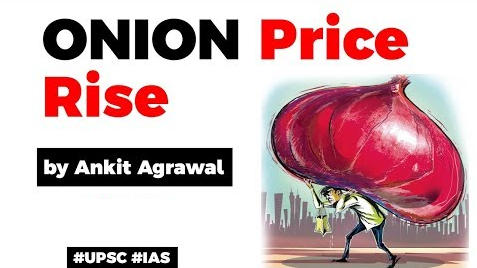Table of Contents

ONIONS IN INDIA
- India is the 2nd largest onion growing country in the world.

- Indian onions are famous for their pungency and are available round the year.
- Indian onions has two crop cycles, first harvesting starts in November to January and the second harvesting from January to May.
- The Major Onion producing states area Maharashtra, Karnataka, Madhya Pradesh, Gujarat.
- Maharashtra ranks first in Onion production with a share of 28.32%.

- It is important not only for internal consumption but also as highest foreign exchange earner among the fruits and vegetables.
- Major Export Destinations (2018-19) : Bangladesh, Malaysia, UAE, Sri Lanka and Nepal.


WHY IS THE PRICE OF ONION ON THE RISE?
- It is a result of last year’s drought and a delayed monsoon this year.
- The situation is compounded by excessive rainfall in onion-growing areas, which has delayed the harvest period by a week or so.
- The excess monsoon in key producer states like Karnataka, Maharashtra, Madhya Pradesh, Gujarat, Rajasthan, Uttar Pradesh, and Bihar, has led to such a steep hike.
SPIKE DURING THIS TIME OF THE YEAR
- Trade analysts suggest onion prices see a spike during this time of the year because of floods and illegal hoarding of onion ahead of the festive season.
WHY THERE IS LESSER SUPPLY DURING THIS TIME?
- It is related to the harvest cycle of onions in the country.
- A majority of the onion crop—about 80%—is grown in the winter or rabi season and sown during the two months of December and January.
- This crop is ready for harvest during April-May.
- A chunk of it is also exported.
- The summer or kharif onion crop is sown during May-June and is reaped during October-November
- . It is when this harvest reaches markets—in about a month’s time—that prices will adequately cool.
MEASURES BY GOVERNMENT
- The government usually tries to check a rise in prices by imposing a temporary minimum export price on onion, as it did on September 13.
- The minimum export price – set currently at US$ 850 a tonne (about Rs 60,300 a tonne)
- At the same time, the government also resorts to imports.
- But both these measures take time.
- The government also tries to augment supplies by releasing onions from federally held stocks (of around 50000-55000 tonne).
- This is the only realistic option of showing quick results in stabilising prices.
- Assuring that the government is taking steps to balance the interest of both farmers and consumers
- The agriculture minister said, The Nafed, which has enough stock of onions, is now releasing stock from the central buffer at a lower price.
- The centre has a buffer stock of 56,000 tonnes of onion, Of which 16,000 tonnes has been offloaded so far. In Delhi, 200 tonnes a day is being offloaded.
- National Cooperative Consumers’ Federation of India have been selling onion from the buffer stock at Rs 22-23/kg.
- While Mother Dairy’s Safal stores are selling at Rs 23.90 per kg in the National Capital.
LONG TERM SOLUTIONS
- The government needs better policy responses–
- Such as creating more refrigerated storage facilities so that surplus onions can be stored longer.
- Increase the rate of processing of onions, so that consumers can quickly substitute onions for onion paste and dehydrated varieties in times of crunch.
- Imports don’t work to cool prices promptly unless they have been signed up much in advance.
- Policymakers therefore need to put together a comprehensive picture of supply-side situations, By connecting production data and weather forecasts much in advance.

OPERATION GREENS
- It was announced in the budget speech of 2018-19.
- The Ministry of Food Processing Industries has launched the scheme.
- It seeks to stabilize the supply of Tomato, Onion and Potato (TOP) crops and to ensure availability of TOP crops throughout the country round the year without price volatility.
Latest Burning Issues | Free PDF






















 WhatsApp
WhatsApp